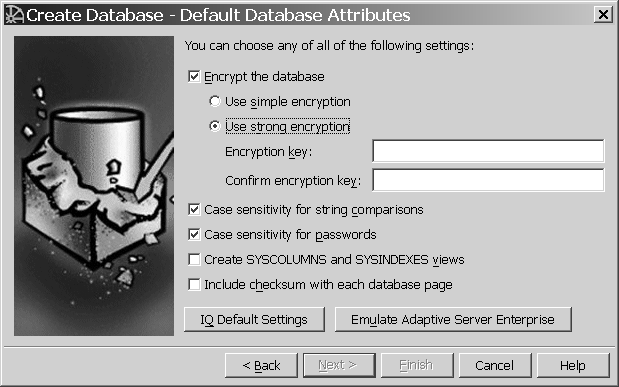Click appropriate checkboxes to select any desired attributes. The options at the bottom of the screen let you use the defaults for Sybase IQ (Alt+Q) or ASE (Alt+U), if preferred. Choosing some attributes displays additional choices, for example:

Encryption makes it harder for someone to decipher the data in your database by using a disk utility to look at the file. File compaction utilities cannot compress encrypted database files as much as unencrypted ones. This attribute is deselected by default.
Simple encryption makes data unreadable, but it could be deciphered by someone with cryptographic expertise. Strong encryption, also called Transport Layer Security (TLS), protects the confidentiality and integrity of network packets as they pass between client and server. Strong encryption uses a 128-bit algorithm and a security key, which is a password you supply.
Case Sensitivity causes all values to be considered case sensitive in comparisons and string operations. Case Sensitivity defaults to ON for Sybase IQ databases.
To support the ISO/ANSI SQL standard semantics, you would select Case sensitivity for both string comparisons and passwords ON (the default).
When you connect to your database, the password that you type need not match the case sensitivity of your database. If you create the database with Case sensitivity for string comparisons OFF, or with Case sensitivity for passwords OFF, the password “SQL” or “sql” will work.
The SYSCOLUMNS view presents the information from the SYS.SYSCOLUMN table in a more readable format. This table includes default settings and primary key information for columns.
The SYSINDEXES view presents the information from the SYSINDEXES and SYSIXCOL tables in a more readable format. These tables include column index information extracted from the host data file or remote server table.
Database page checksums are used to detect whether a database page has been modified on disk. When a database is created with checksums enabled, a checksum is calculated for each Catalog Store page before it is written to disk. When a Catalog Store page is read from disk, its checksum is recalculated and compared to the stored checksum. If the values differ, the page has been modified or otherwise corrupted while on disk. Checksums apply to the Catalog Store only, not the IQ Store.
When you have finished selecting database attributes, click Next.